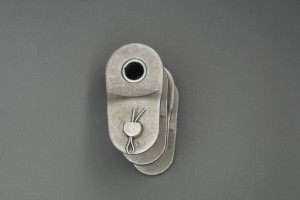Roller chains are an important component in many mechanical systems, providing a reliable and efficient way to transmit power from one rotating shaft to another. They are commonly used in a wide range of applications including industrial machinery, agricultural equipment and automotive systems. Understanding the five main parts of a roller chain is critical to maintaining and troubleshooting these systems.
Inner link: The inner link is an important part of the roller chain, which constitutes the core structure of the chain. It consists of two inner panels connected by a pair of pins. The inner panels are typically made from high-quality steel, providing the necessary strength and durability to meet the needs of the application. The pins are press-fit into the inner panels, creating a safe and secure connection. The inner connecting rod also has bushings that serve as bearing surfaces for the rollers.
Outer Links: Outer links are another important component of roller chains, providing a means of connecting inner links together to form a continuous ring. Like the inner link, the outer link consists of two outer plates that are connected by a pair of pins. The outer plates are designed to withstand the tensile forces exerted on the chain, ensuring that the chain remains intact and functioning properly under load. The outer link also has a roller that is mounted on a bushing to reduce friction when the chain engages the sprocket.
Roller: Roller is a key component of the roller chain. It facilitates smooth meshing with the sprocket and reduces wear of the chain and sprocket teeth. The rollers are mounted on bushings, which provide a low-friction interface with the sprocket teeth, allowing the chain to transmit power efficiently. Rollers are typically made of hardened steel or other durable materials to withstand harsh applications. Proper lubrication of the rollers is essential to ensure smooth operation and extend the life of the chain.
Bushing: The bushing acts as a bearing surface for the roller, allowing it to rotate freely and reducing friction as the chain engages the sprocket. Bushings are typically made from high-quality materials, such as bronze or sintered metal, to provide a durable and low-friction interface with the rollers. Proper lubrication of bushings is critical to minimizing wear and ensuring smooth operation of the roller chain. In some roller chain designs, the bushings can be self-lubricating, further improving chain performance and life.
Pin: The pin is a key component of the roller chain as it is used to connect the inner and outer links together to form a continuous ring. The pins are press-fit into the inner plate of the inner link, providing a safe and secure connection. Pins are usually made of hardened steel to withstand the tensile forces exerted on the chain. Proper maintenance of pins, including regular inspection for wear and proper lubrication, is critical to ensuring the integrity and service life of your roller chain.
In summary, understanding the five main components of a roller chain is critical to maintaining and troubleshooting these critical components in a mechanical system. Inner links, outer links, rollers, bushings and pins play a vital role in ensuring the smooth and reliable operation of roller chains. Proper maintenance, including regular inspections and lubrication, is critical to maximizing the service life and performance of roller chains in a variety of applications.
Post time: May-17-2024

